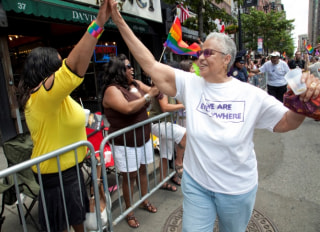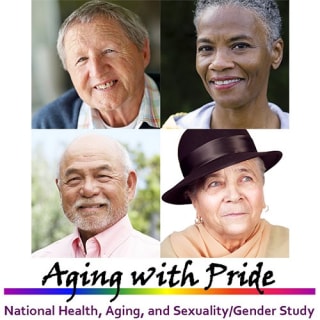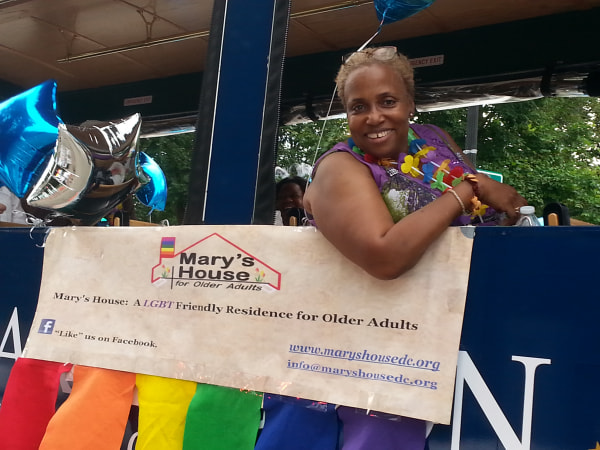by CHANDRA THOMAS WHITFIELD
FULL ARTICLE
Cecelia Hayden Smith, 72, knows exactly how she wants to live out the remainder of her golden years: lounging lazily on the porch of a cozy house tucked along a quiet, treelined street in Washington, D.C.
She’d greet her partner each morning with a homemade country breakfast, and their afternoons and evenings would be filled with lively games of Spades and Bid Whist with a dozen or so housemates — all fellow LGBTQ elders.

The sparse research available on black LGBTQ elders reveals chronic levels of discrimination, poverty, social isolation and physical and mental health disparities. SAGE
“I’ve already picked out my rocking chair,” the retired substance abuse counselor quipped. “Just call me ‘Mama C,’ and make sure my room is in the front, so I can always see everything going on, and I’m happy.”
For now, her dream is in stark contrast of her reality. She and her partner of 30 years, a 78-year-old woman whose names she prefers not to mention, have had health challenges, forcing them to live on a fixed budget in pricey Washington, D.C.
They can only afford to live in a crumbling six-bedroom townhome, which they share with three middle-aged and older straight and lesbian women. After the basics, much of their income is spent on health care and, often, an ever-growing list of repairs for the house, which has been in her partner’s family for more than six decades.
Hayden Smith and her partner are among the estimated 2.7 million adults age 50 and older in the U.S. who self-identify as lesbian, gay, bisexual, transgender and queer (LGBTQ) — about 1.1 million are 65 and older. Approximately 20 percent of LGBTQ older adults are people of color, a number expected to double by 2050.
A Triple Threat?
Although economic, social, physical and mental health disparities are high among all LGBTQ older adults, the complexities of race, age, sexual orientation and gender identity are especially challenging for many black LGBTQ elders. And advocates say public policy changes, such as the Trump administration’s promised repeal of the Affordable Care Act, which in its most recent version includes deep cuts to Medicaid, will make their predicament worse.
report co-authored by Services and Advocacy for GLBT Elders (SAGE) and LGBTQ think-tank Movement Advancement Project (MAP).
Advocates attribute the economic disparities of black LGBTQ elders to longstanding race, age and LGBTQ discrimination, which has been exacerbated by a lack of equal protection under the law and social stigma. Neglect and isolation are especially prevalent when their peers — the only support network many of them have due to family rejection — die off or age themselves, as research shows older LGBTQ adults are less likely to be partnered or married or to have children to depend on as caregivers.
“Our generation did so much [for LGBTQ and civil rights], we shouldn’t just be thrown away,” Hayden Smith said. “It’s sad, but so many of us feel invisible as we get older. If we don’t take care of ourselves, we’re going to get lost in the sauce.”

Aging with Pride: National Health, Aging and Sexuality/Gender Study is the first federally-funded longitudinal national project designed to better understand the aging, health and well-being of LGBTQ midlife and older adults and their families. Aging with Pride
Root Causes
“African-Americans reported the highest levels of lifetime LGBTQ-related discrimination, and both African-Americans and Hispanics reported lower levels of household income, education, affirmation of their identities and social support compared to non-Hispanic white LGBTQ older adults,” said Dr. Karen Fredriksen-Goldsen, lead researcher on the "Aging With Pride: National Health, Aging and Sexuality/Gender Study."
Though not focused exclusively on elders of color, her study, the largest ever nationally on LGBTQ older adults, found a common bond among African-American and Hispanic LGBTQ older adults.
2014 SAGE report found African-American LGBTQ older adults were four times more likely than their Hispanic and white counterparts — 26 percent versus 8 percent — to consider people from their churches or faith as part of their support systems.
Jenna McDavid, of the Diverse Elders Coalition, said this information provides great opportunity: “Exploring more ways for faith communities to be inclusive could be monumental for so many elders in need of support," she explained.

Dr. Imani Woody is working to raise $2 million to transform her childhood home into Mary's House D.C., an affordable, independent living home for LGBTQ elders. Plans call for 15 efficiency units and, on the grounds, a "stone wall," commemorating the 1969 historic Stonewall riots. Courtesy Mary's House D.C.
Discrimination and Isolation
While many advocates say the legalization of same-sex marriage has been helpful to the well-being of LGBTQ elders, many who have not married still struggle to receive the financial and family protections afforded to unmarried, different-sex couples – especially after their partner dies or suffers a chronic illness.
Nursing homes and other long-term care facilities are especially problematic for black LGBTQ elders, according to Kenneth Mitchell, 62, a black gay man living in New Orleans. “The fear of abuse and discrimination [is so strong that many] end up going back into the closet,” he said.
“People need to be able to be their true selves; being fearful and stressed impacts your quality of life and your physical and mental health," added Mitchell, who serves as a board member for New Orleans Advocates for GLBT Elders (NOAGE).
Cedric Burgess, 65, a black gay man in Washington D.C., agrees that a fear of backlash and discrimination pushes many to retreat. “It’s not the same as being a young gay person; there’s less to do, and many of our peers have died from the AIDS epidemic,” he said. “One of the biggest concerns is isolation and suicide. People need people to talk to.”
Click for full article
FULL ARTICLE
Cecelia Hayden Smith, 72, knows exactly how she wants to live out the remainder of her golden years: lounging lazily on the porch of a cozy house tucked along a quiet, treelined street in Washington, D.C.
She’d greet her partner each morning with a homemade country breakfast, and their afternoons and evenings would be filled with lively games of Spades and Bid Whist with a dozen or so housemates — all fellow LGBTQ elders.

The sparse research available on black LGBTQ elders reveals chronic levels of discrimination, poverty, social isolation and physical and mental health disparities. SAGE
“I’ve already picked out my rocking chair,” the retired substance abuse counselor quipped. “Just call me ‘Mama C,’ and make sure my room is in the front, so I can always see everything going on, and I’m happy.”
For now, her dream is in stark contrast of her reality. She and her partner of 30 years, a 78-year-old woman whose names she prefers not to mention, have had health challenges, forcing them to live on a fixed budget in pricey Washington, D.C.
They can only afford to live in a crumbling six-bedroom townhome, which they share with three middle-aged and older straight and lesbian women. After the basics, much of their income is spent on health care and, often, an ever-growing list of repairs for the house, which has been in her partner’s family for more than six decades.
Hayden Smith and her partner are among the estimated 2.7 million adults age 50 and older in the U.S. who self-identify as lesbian, gay, bisexual, transgender and queer (LGBTQ) — about 1.1 million are 65 and older. Approximately 20 percent of LGBTQ older adults are people of color, a number expected to double by 2050.
A Triple Threat?
Although economic, social, physical and mental health disparities are high among all LGBTQ older adults, the complexities of race, age, sexual orientation and gender identity are especially challenging for many black LGBTQ elders. And advocates say public policy changes, such as the Trump administration’s promised repeal of the Affordable Care Act, which in its most recent version includes deep cuts to Medicaid, will make their predicament worse.
report co-authored by Services and Advocacy for GLBT Elders (SAGE) and LGBTQ think-tank Movement Advancement Project (MAP).
Advocates attribute the economic disparities of black LGBTQ elders to longstanding race, age and LGBTQ discrimination, which has been exacerbated by a lack of equal protection under the law and social stigma. Neglect and isolation are especially prevalent when their peers — the only support network many of them have due to family rejection — die off or age themselves, as research shows older LGBTQ adults are less likely to be partnered or married or to have children to depend on as caregivers.
“Our generation did so much [for LGBTQ and civil rights], we shouldn’t just be thrown away,” Hayden Smith said. “It’s sad, but so many of us feel invisible as we get older. If we don’t take care of ourselves, we’re going to get lost in the sauce.”

Aging with Pride: National Health, Aging and Sexuality/Gender Study is the first federally-funded longitudinal national project designed to better understand the aging, health and well-being of LGBTQ midlife and older adults and their families. Aging with Pride
Root Causes
“African-Americans reported the highest levels of lifetime LGBTQ-related discrimination, and both African-Americans and Hispanics reported lower levels of household income, education, affirmation of their identities and social support compared to non-Hispanic white LGBTQ older adults,” said Dr. Karen Fredriksen-Goldsen, lead researcher on the "Aging With Pride: National Health, Aging and Sexuality/Gender Study."
Though not focused exclusively on elders of color, her study, the largest ever nationally on LGBTQ older adults, found a common bond among African-American and Hispanic LGBTQ older adults.
2014 SAGE report found African-American LGBTQ older adults were four times more likely than their Hispanic and white counterparts — 26 percent versus 8 percent — to consider people from their churches or faith as part of their support systems.
Jenna McDavid, of the Diverse Elders Coalition, said this information provides great opportunity: “Exploring more ways for faith communities to be inclusive could be monumental for so many elders in need of support," she explained.

Dr. Imani Woody is working to raise $2 million to transform her childhood home into Mary's House D.C., an affordable, independent living home for LGBTQ elders. Plans call for 15 efficiency units and, on the grounds, a "stone wall," commemorating the 1969 historic Stonewall riots. Courtesy Mary's House D.C.
Discrimination and Isolation
While many advocates say the legalization of same-sex marriage has been helpful to the well-being of LGBTQ elders, many who have not married still struggle to receive the financial and family protections afforded to unmarried, different-sex couples – especially after their partner dies or suffers a chronic illness.
Nursing homes and other long-term care facilities are especially problematic for black LGBTQ elders, according to Kenneth Mitchell, 62, a black gay man living in New Orleans. “The fear of abuse and discrimination [is so strong that many] end up going back into the closet,” he said.
“People need to be able to be their true selves; being fearful and stressed impacts your quality of life and your physical and mental health," added Mitchell, who serves as a board member for New Orleans Advocates for GLBT Elders (NOAGE).
Cedric Burgess, 65, a black gay man in Washington D.C., agrees that a fear of backlash and discrimination pushes many to retreat. “It’s not the same as being a young gay person; there’s less to do, and many of our peers have died from the AIDS epidemic,” he said. “One of the biggest concerns is isolation and suicide. People need people to talk to.”
Click for full article